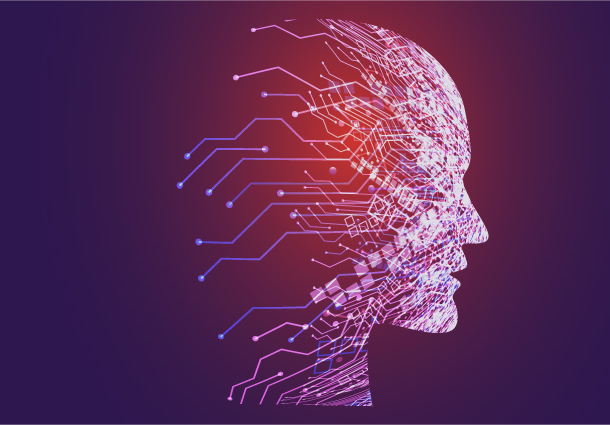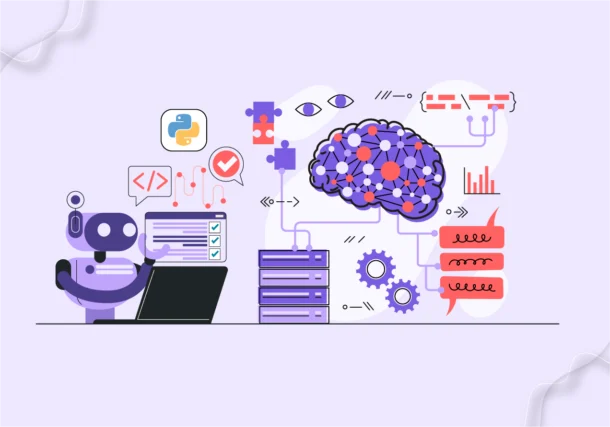The Mutualism of NLP and Deep Learning Transformation by Baring the Bond
The combination of Deep Learning in NLP represents a turning point in the development of contemporary technology. A branch of artificial intelligence (AI) called deep learning allows machines to imitate the neural networks seen in the human brain by learning complex patterns and representations from large datasets. NLP, on the other hand, bridges the gap between human communication and machine comprehension by enabling machines to perceive, interpret, and produce human language.

The convergence of Deep Learning with NLP represents a paradigm shift in the way robots understand and interpret human language as well as how humans interact with technology. From language translation and sentiment analysis to chatbots and virtual assistants, this combination has produced ground-breaking innovations in several fields. NLP systems can now comprehend context, semantics, and even subtleties in human language by utilizing Deep Learning techniques like transformers and recurrent neural networks (RNNs). This allows for more precise and context-aware interactions.
The revolutionary potential of this symbiotic relationship becomes apparent when we delve deeper into the role of Deep Learning in the advancement of NLP. When Deep Learning and Natural Language Processing are combined, there are never-before-seen possibilities for innovation and development, ranging from improving communication channels to transforming information retrieval and knowledge extraction. Organizations and researchers can use Deep Learning to drive natural language processing (NLP) to new heights by breaking down barriers and redefining the bounds of what is possible in this dynamic interplay. This can be done by developing a deeper knowledge of this interplay.
A Symbiotic Alliance for Evolutionary Progress of Deep Learning in NLP
A new era of revolutionary improvements in Natural Language Processing (NLP) has begun with the inclusion of Deep Learning. The way machines understand and produce human language has been completely transformed by Deep Learning, which can learn on its own from enormous volumes of data. With this paradigm change, natural language processing (NLP) systems can now do tasks like sentiment analysis, text summarization, and language translation with never-before-seen accuracy and efficiency.
Neural networks—which are modeled after the anatomy and physiology of the human brain—are the fundamental tool used in deep learning in natural language processing. With the help of enormous text databases, these neural networks are taught to recognize complex linguistic patterns and relationships. The subtleties of human language, such as context, semantics, and syntax, can be remarkably accurately captured by Deep Learning models using methods like transformers and recurrent neural networks (RNNs).

Beyond only recognizing patterns, Deep Learning in NLP works well together. It makes it easier to create intelligent systems with capabilities that are similar to human cognition, such as the ability to comprehend, interpret, and produce human language. NLP has advanced beyond conventional rule-based techniques by utilizing Deep Learning, opening up new possibilities in fields like chatbots, virtual assistants, and automated content creation.
This mutually beneficial relationship does, however, come with certain drawbacks, such as the requirement for enormous volumes of annotated data, computer power, and model creation and tuning experience. Furthermore, rigorous attention must be paid to ethical issues of prejudice, justice, and privacy to guarantee the responsible implementation of NLP systems driven by Deep Learning.
Despite these challenges, the integration of Deep Learning in NLP holds immense promise for driving innovation and progress in various domains, from healthcare and education to finance and customer service. As researchers and practitioners continue to explore and refine these technologies, the evolution of NLP powered by Deep Learning is poised to reshape the way we interact with and leverage language in the digital age.
Deep Learning’s Potential in Natural Language Processing (NLP) Applications
Natural language processing (NLP) has seen a paradigm shift due to deep learning, which is changing the way machines comprehend and communicate with human language. Deep learning is essentially the process of training neural networks on vast amounts of data so that they can recognize patterns and features on their own. This allows for more precise and complex language processing.
Deep learning for natural language processing (NLP) techniques is useful in many applications, ranging from information extraction and named entity recognition to text categorization and sentiment analysis. These methods open up new possibilities in fields like content moderation, customer service automation, and tailored recommendations by enabling machines to read and comprehend text in a way that closely mimics human comprehension.
Being able to handle unstructured data—like text—with amazing flexibility and scalability is one of deep learning’s main advantages in natural language processing. In contrast to deep learning models, which can automatically learn from the data and adapt to various linguistic settings, traditional rule-based systems frequently struggle with the complexity and nuances of natural language.
NLP models based on deep learning have made great strides in areas such as language production and machine translation, allowing for accurate and natural-sounding cross-linguistic communication. By removing linguistic obstacles and promoting cross-cultural interaction, these developments have opened the door for international cooperation and communication.
NLP has even more intriguing potential ahead of it as deep learning advances. With continued study and development, we may anticipate advancements in fields such as language synthesis, conversational AI, and contextual awareness, which may result in more sophisticated and human-like interactions between machines and people.
Our ability to process, evaluate, and produce natural language text has changed as a result of deep learning’s integration with NLP. Through the utilization of neural networks and large datasets, deep learning has revolutionized natural language processing (NLP) by providing hitherto unseen capacities for comprehending, translating, and producing natural language.
Deep Learning’s Dynamic Iterative Jaunt by Transforming NLP Landscape
Natural Language Processing (NLP), a combination of Deep Learning, has led to a revolutionary change in the way machines understand and produce human language. Cutting-edge developments in deep neural networks and complex algorithms designed specifically for NLP applications are the driving forces behind the current development. Fundamentally, this merger gives computers the ability to comprehend, produce, and analyze writing like a human with previously unheard-of precision and fluency.

Deep Learning approaches have revolutionized text categorization, sentiment analysis, named entity recognition, and information extraction. They have also sparked important discoveries across numerous NLP applications. NLP models can identify complex linguistic patterns, subtleties, and contextual clues that are buried inside enormous amounts of text data by utilizing the power of deep neural networks. Consequently, algorithms can now accurately and efficiently extract important insights, recognize entities, and discern feelings from unstructured textual data.
The emergence of transformational systems like the Transformer model is a major factor driving the development of NLP driven by deep learning. Long-range dependencies and more efficient contextual comprehension have been made possible by these attention-driven architectures, which have completely changed how computers interpret sequential data. Furthermore, pre-trained language models such as Generate Pre-trained Transformer (GPT) and Bidirectional Encoder Representations from Transformers (BERT) have revolutionized the field of NLP. These models have an intrinsic grasp of language semantics and syntax since they have been trained on enormous corpora of text data. As a result, they require little fine-tuning to do a wide range of natural language processing tasks.
Transfer learning strategies have made natural language processing more accessible by facilitating the transfer of knowledge from trained models to tasks that require less annotated material downstream. NLP applications can be developed and implemented more quickly across a variety of areas by fine-tuning these models on particular tasks. Therefore, the combination of Deep Learning for Natural Language Processing has not only improved the functionality of current systems but also created new opportunities, stimulating creativity and propelling the advancement of language-centric AI technologies.
Challenges and Opportunities in Deep Learning-NLP Integration
AI-driven language understanding is changing as a result of the possible problems presented by the connection between deep learning and natural language processing (NLP). One major obstacle is how difficult it is for language models to handle context and ambiguity. Even while deep learning methods are excellent at handling large volumes of data, language subtleties can make it difficult to resolve ambiguity and interpret context correctly. New model designs and training approaches that improve contextual comprehension and disambiguation are needed to meet this issue.
Deep learning-NLP integration raises several ethical and data privacy issues. Large datasets are used to train deep learning models, which present issues with consent, data privacy, and handling sensitive data responsibly. As AI systems are used increasingly often to analyze and produce natural language, it is crucial to make sure that ethical standards and legal frameworks are followed. To build trust and encourage the ethical application of AI-driven NLP technologies, it is imperative to strike a balance between innovation and morality.
NLP and deep learning together offer a wealth of chances for innovation and progress, despite these obstacles. Research will continue to explore new areas of language interpretation while attempting to address current issues. There are opportunities to construct more complex NLP applications by utilizing pre-trained language models like BERT and GPT and deep learning models like transformers. Additionally, transfer learning and fine-tuning methods provide ways to modify taught models to fit particular NLP tasks, improving effectiveness and performance.
A Trail Ahead with Pattem Digital; Deep Learning Empowerment in NLP
Natural language processing (NLP) is being revolutionized by Deep Learning, which provides cutting-edge capabilities for jobs like text classification, sentiment analysis, and machine translation. NLP’s potential has been redefined by its complex models, such as the Transformer architecture, and pre-trained language models, like BERT and GPT. Nevertheless, there are drawbacks to this integration as well, such as managing ambiguity and protecting data privacy. The future of deep learning in natural language processing (NLP) holds ground-breaking discoveries and game-changing uses as we work through these challenges. Using Pattem Digital as a Deep learning consulting company to embrace this transition guarantees access to solutions that leverage Deep Learning to improve Natural Language Processing (NLP) skills, fostering innovation and competitiveness in the digital space.





